Wednesday 16 April 1941
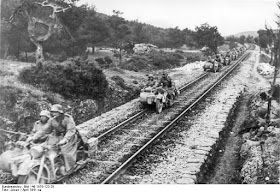 |
| Motorcyclists of Panzer Regiment 3 rolling toward the Platamon Railway tunnel. Things are going so smoothly that the lead motorcyclist appears to be enjoying a smoke (Jesse, Federal Archives). |
Operation Marita/Operation 25: Things are going poorly for the Allies in the Balkans on 16 April 1941. The Yugoslav government - what there is left of it in the country, most of it already having fled to Greece - sues for peace. The two sides arrange a meeting to discuss terms, but the Yugoslav representative is considered by the Germans to have insufficient authority to sign such a document. They send him back to Belgrade with a draft and continue their operations.
Croatian strongman (and Mussolini pawn) Ante Pavelic assumes power over the Independent State of Croatia.
General Henry Maitland Wilson, commander of the British forces in Greece, meets with Greek Commander-in-chief Papagos at Lamia. He tells Papagos that the British are retreating to Thermopylae. This effectively cedes all of northern and central Greece to the Wehrmacht.
The British retrograde move to the south is complicated. Australian Lieutenant General Thomas Blamey, in charge of the ANZAC units which comprise the bulk of the British forces, has only a few good north/south roads at his disposal. General Freyberg commands the New Zealand Division which holds the center of the withdrawal, while Australian General Mackey's troops guard the flanks. The first switch position is a line running through the city of Larissa, the main communications center in the region. The Australians and New Zealanders have to get to this new line in good order - and before the Germans do.
The Germans of Kampfgruppe (Hermann) Balck are not giving Blamey much time. They are heading south at lightning speed. It is Blitzkrieg at its ultimate, motorcyclists leading the way, followed by the panzers. They are following an open, undefended road - but actually, it's not a road at all, but a single-track coastal railway.
The coast railway line, however, is interrupted at Platamon, north of Larissa, by a large ridge on which sits Platamonas Castle. Under the ridge is a convenient tunnel (there are new, larger tunnels nearby, but this is a one-track tunnel). Wehrmacht motorcyclists have been using the railway tracks on the drive south from Katerini like a road, and, once past the Platamon ridge, the railway and nearby roads lead south all the way to Athens. The Germans intend to roll through the tunnel to continue the journey south on the tracks.
Unfortunately for the Germans, however, the New Zealand 21st Battalion has been in position there since the end of March and is blocking the tunnel. The Germans halted before the New Zealanders late on the 15th after making a perfunctory attack, but today the Germans make a determined effort.
Basically, the Germans are trying to seize a shortcut that would give them a quick route to Larissa and the main roads south that the city controls. Without it, they would have to make a circuitous journey through a gorge to the west between two mountains (Ossa Oros and Olympus Oros) or surmount the coastal mountain that the tunnel cuts through. The tunnel is critical for the bulk of the division's panzers to continue on this route in any timely fashion. If the Germans can take the tunnel, the short road to Larissa and Athens lies open, with the prospect of trapping huge Allied formations still evacuating from the north.
Exterior view of the old Platamon railway tunnel. (This photo of Platamonas Castle is courtesy of TripAdvisor).
At dawn, the German Kradschützen Truppen-Bataillon 2 (Motorcycle Battalion 2) of the 3rd Panzer Division attacks, preceded by mortar fire. The Germans make good progress, and around 09:00 about 50 panzers (PzKpfw IIs) arrive and start pounding the New Zealand positions. Some of the New Zealanders on the flanks withdraw, while others on the main hill hold firm.
The New Zealanders are overwhelmed by 10:15, when Lieutenant Colonel N. Macky, in charge of the 21st Battalion, issues the order to retreat. They block the tunnel - it is not completely destroyed, but demolished enough to prevent a quick pursuit. In one version of the battle, they blow explosive charges to seal it; in another, they disable a panzer in the tunnel, blocking it. Either way, the Germans can't use the tunnel quickly enough for it to be practical. Their German motorcyclists suffer 25% casualties during the attack and their unit is pulled out of the line.
Without the Platamon tunnel, the men of the I,/Panzer Regiment 3 have a decision to make: go west, or try to get over the ridge. By mid-day, they begin across the ridge on a narrow mule track. However, it is very rough going. The Panzer IIs are narrower than Panzer IIIs and would make it over the ridge easier, but the Panzer IIs were all disabled during the morning attack. The Panzer IIIs start across but begin losing their tracks on the uneven and rocky surface or experience other issues with the slope and narrow path. Every time a panzer is disabled, it stops the entire column. Frustrated, the tankers try to go off-road - two get stuck in a swamp and a third runs into a minefield. After losing several tanks, the Germans late in the day finally clear the mule track, sweep it for mines, and get their tanks across - a process that would have taken fifteen minutes through the tunnel.
The New Zealand troops, meanwhile, use a ferry to cross a nearby river in a gorge. They then sink the ferry and take up defensive positions in the gorge.
Elsewhere, the Italians advancing down the Yugoslav coast occupy Split. They also make small gains in Albania as the Greeks pull out. The German 6th Mountain Division, taking the slow route, advances along mountain paths on Mount Olympos.
The Luftwaffe bombs and sinks 4359 ton Greek freighter Memas at Chalkis, Greece.
A Yugoslavian submarine, the Nebojsa, and two torpedo boats, the Kajmakcalan and Durmitor, leave port to escape the advancing Germans.
Royal Navy armed boarding vessel HMS Chakla runs aground in stormy weather, but later is towed off by net layer HMS Protector.
European Air Operations: The Luftwaffe on the Channel Front has entered one of its active phases again. So far in 1941, it has had long spells of inactivity, followed by bursts of heavy raids. Last night, the main target was Belfast (that raid only ends at 05:00 today), and tonight it is London.
There is another reason for the ferocity, indeed savagery, of tonight's raid, and it has nothing to do with London specifically. Adolf Hitler and Hermann Goering send in the bombers in seemingly endless waves because of the Paris Opera House. One of the favored forms of amusement for the Third Reich's leaders is in the opera - it is not only their preferred form of music but a major form of socializing outside of the work environment. However, the RAF threw a spanner in the works with their raid on Berlin of 9 April which devastated the Paris Opera House. Hitler has ordered the building rebuilt and London flattened in reprisal.
About 300 bombers participate, and they each fly multiple sorties. This is one of the biggest raids of the entire Blitz, rivaling the one at the end of December and some of the others from 1940. The bombers make two and even sometimes three sorties, for a total of 685 payloads dropped over the city. The East End takes tremendous damage. This is probably not coincidental, as it plays to Hitler's pet theory that he can stir up class resentment against the "Plutocrats" by targeting certain districts. British night air defenses are getting better, and the Luftwaffe loses half a dozen bombers. There is no question that tonight's raid is one of the climaxes of the Blitz, perhaps not a turning point but with subtle hints of change in the air.
In a sense, Hitler achieves his aim of revenge in one grisly respect. Among the casualties of the night's raid is Al Bowlly, a Mozambican-born South African/British music hall performer. Thus, both sides are deprived of musical entertainment as a result of the initial RAF raid.
Visiting Australian Prime Minister Robert Menzies is in London during the attack. He hears the bombers overhead but believes at first that they are heading further west. He notes that "a dozen large bombs fell within 100 yards" of his hotel. The room he is in is damaged, with the windows and door blown in. He notes that "The sky beyond the Palace was red with fire and smoke, the sky was flashing like lightning." At 05:00 on the 17th, he surveys the damage, and finds that "buildings were blazing" on Brook Street and that "gas mains blazed in Piccadilly." He wonders: "How can it go on for years?"
RAF Bomber Command continues its mission of attacking Axis shipping. Bristol Blenheim Mark IVs of No. 110 Squadron of No. 2 Group bomb Heligoland, while other Blenheims of No. 107 Squadron spot a submarine off Prestkjac, Norway and get a couple of near misses. Other similar operations are made, and overall, the RAF loses a couple of bombers. The RAF also conducts a Circus sweep over Berck-sur-Mer.
Kommodore Werner Mölders of Stab./JG 51 shoots down two Hurricanes of RAF No. 601 Squadron in a Bf 109F. This gives him 65 claims and opens some ground between him and No. 2 Adolf Galland.
Battle of the Atlantic: During the April 15/16 night bombing of Belfast, aircraft carrier HMS Furious is lightly damaged. The damage does not interfere with operations.
The Luftwaffe bombs and sinks three ships, 1151-ton British freighter Angelesea Rose, 1548 ton British freighter Amiens and 1167 ton Norwegian freighter Bolette, north of St. Ives at the mouth of the Bristol Channel. There are eight deaths on the Amiens.
The Luftwaffe bombs and sinks 2826-ton Norwegian freighter Favorit south of the Faroe Islands. Everyone survives.
The Luftwaffe bombs and damages 159-ton British trawler King Athelstan near Ballinskelligs, Ireland. The skipper beaches the ship, but it later floats off after minor repairs and makes it to port.
The Luftwaffe damages British 5379-ton freighter Swedru in the Northwest Approaches. There are 24 deaths, including 7 passengers. The ship remains afloat as a derelict and eventually has to be sunk by gunfire.
German raider Kormoran is southwest of the Azores, on her way back to Germany, when the lookouts spot the 7739-ton Swedish iron ore carrier Sir Ernest Cassel. The Kormoran takes the crew aboard as guests/POWs depending on their nationality, then scuttles Sir Ernest Cassel. This is the final hostile encounter by the Kormoran on its first cruise, which began on 6 June 1940.
British 1578 ton collier Parnu collides with freighter Fluor about a dozen miles off Cape Wrath, Scotland. The Parnu eventually sinks.
The Kriegsmarine supply network remains active in the Atlantic, as tanker Nordmark refuels Italian submarines Archimede, Ferraris, and Gugliemotti.
Convoy OB 311 departs from Liverpool, Convoy HX 121 departs from Halifax.
Battle of the Mediterranean: The British have come to the realization that the battle for North Africa will be decided at sea. Specifically, the key area is the convoy route from Naples to Tripoli. Accordingly, they are positioning submarines in this area, and also sending surface patrols there at night.
Captain P.J. Mack is leading the 14th Destroyer Flotilla, composed of HMS Janus, Jervis, Mohawk, and Nubian and based in Malta, on a more-or-less routine patrol off Tunisia. His lookouts spot an Italian/German convoy commanded by Commander Pietro de Cristofaro. It is composed of five freighters and escorted by three Italian destroyers. Mack attacks the convoy (called the "Tarigo Convoy" after the lead escort destroyer) and sinks not only all five freighters/transports but also all three of the destroyers. Mack accomplishes this at the price of the Mohawk, which is scuttled off the Kerkenneh Islands. There are 168 survivors of the Mohawk and 43 deaths.
On the German side, there are 384 deaths of men who had been en route to the Afrika Korps, mainly from the 15th Panzer Division. The Italian navy puts to sea and eventually rescues 1248 out of about 3000 men who had been on the sunk ships.
The Axis ships lost are:
On land, Lieutenant General Erwin Rommel "personally, from the most forward lines" leads an attack on the Tobruk perimeter (quotes are from the Afrika Korps War Diary). This is at Ras Mdaauar. He uses his Italian forces, specifically the armored battalion of the Ariete Division and infantry from the Trento Division. The attack fails "because of the hesitant advance of the armored battalion" of the Ariete Division. The War Diary notes sourly that two Italian companies surrendered without putting up any fight.
General Wavell hurriedly stops further convoys of Operation Lustre bringing troops from Egypt to Greece. From now on, the convoys will move in the other direction, evacuating the expeditionary forces from Greece.
The British attempt a commando-style raid on Bardia, but the ships embarking the troops are recalled due to poor weather. The operation is rescheduled for when the skies clear. Another such raid is attempted on Marakeb, Libya, but destroyer HMS Decoy runs aground and the operation cannot be completed.
The first shipment of food to Great Britain under Lend-Lease arrives.
Anglo/Japanese Relations: The Japanese government issues a statement flatly denying that it has any designs on Singapore.
US/Canadian Relations: Canadian Prime Minister Mackenzie King visits with President Roosevelt. They will spend the next four days conferring in Washington, Virginia Beach and Roosevelt's home at Hyde Park. At some point during these meetings, they sign a defense production agreement.
US Military: MacDill Air Force Base, operational since 16 April 1940, receives its name today. It is named after World War I veteran Colonel Leslie MacDill.
British Homefront: Around this date, the British demolish with explosives the north water tower of the old Crystal Palace. This is simply done - there is no reason given or fuss made about it. The Crystal Palace grounds are being used to manufacture radar equipment, and the reason may be to make more room for this. Another conjecture is that the tower provides a navigational aid to Luftwaffe crews. In any event, it is the final and definitive end to the 1851 Hyde Park structure.
Minister of Labour Ernest Bevin introduces a National Registration of Women for war work. Previous attempts to enlist women had been voluntary; this is compulsory. The first registrations for the youngest (20-21) age group are set for 19 April 1941.
April 1941
April 1, 1941: Rommel Takes Brega
April 2, 1941:Rommel Takes Agedabia
April 3, 1941: Convoy SC-26 Destruction
April 4, 1941: Rommel Takes Benghazi
April 5, 1941: Rommel Rolling
April 6, 1941: Operation Marita
April 7, 1941: Rommel Takes Derna
April 8, 1941: Yugoslavia Crumbling
April 9, 1941: Thessaloniki Falls
April 10, 1941: USS Niblack Attacks
April 11, 1941: Good Friday Raid
April 12, 1941: Belgrade and Bardia Fall
April 13, 1941: Soviet-Japanese Pact
April 14, 1941: King Peter Leaves
April 15, 1941: Flying Tigers
April 16, 1941: Battle of Platamon
April 17, 1941: Yugoslavia Gone
April 18, 1941: Me 262 First Flight
April 19, 1941: London Smashed
April 20, 1941: Hitler's Best Birthday
April 21, 1941: Greek Army Surrenders
April 22, 1941: Pancevo Massacre
April 23, 1941: CAM Ships
April 24, 1941: Battle of Thermopylae
April 25, 1941: Operation Demon
April 26, 1941: Operation Hannibal
April 27, 1941: Athens Falls
April 28, 1941: Hitler Firm about Barbarossa
April 29, 1941: Mainland Greece Falls
April 30, 1941: Rommel Attacks
2020
Croatian strongman (and Mussolini pawn) Ante Pavelic assumes power over the Independent State of Croatia.
General Henry Maitland Wilson, commander of the British forces in Greece, meets with Greek Commander-in-chief Papagos at Lamia. He tells Papagos that the British are retreating to Thermopylae. This effectively cedes all of northern and central Greece to the Wehrmacht.
The British retrograde move to the south is complicated. Australian Lieutenant General Thomas Blamey, in charge of the ANZAC units which comprise the bulk of the British forces, has only a few good north/south roads at his disposal. General Freyberg commands the New Zealand Division which holds the center of the withdrawal, while Australian General Mackey's troops guard the flanks. The first switch position is a line running through the city of Larissa, the main communications center in the region. The Australians and New Zealanders have to get to this new line in good order - and before the Germans do.
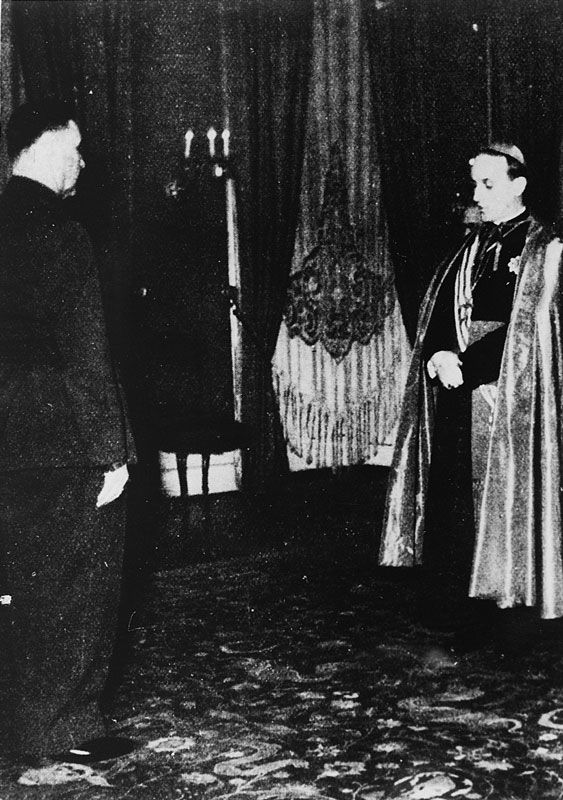 |
| Ante Pavelić at a ceremony with Archbishop Alojzije Stepinac in Zagreb, 16 April 1941. |
The coast railway line, however, is interrupted at Platamon, north of Larissa, by a large ridge on which sits Platamonas Castle. Under the ridge is a convenient tunnel (there are new, larger tunnels nearby, but this is a one-track tunnel). Wehrmacht motorcyclists have been using the railway tracks on the drive south from Katerini like a road, and, once past the Platamon ridge, the railway and nearby roads lead south all the way to Athens. The Germans intend to roll through the tunnel to continue the journey south on the tracks.
Unfortunately for the Germans, however, the New Zealand 21st Battalion has been in position there since the end of March and is blocking the tunnel. The Germans halted before the New Zealanders late on the 15th after making a perfunctory attack, but today the Germans make a determined effort.
Basically, the Germans are trying to seize a shortcut that would give them a quick route to Larissa and the main roads south that the city controls. Without it, they would have to make a circuitous journey through a gorge to the west between two mountains (Ossa Oros and Olympus Oros) or surmount the coastal mountain that the tunnel cuts through. The tunnel is critical for the bulk of the division's panzers to continue on this route in any timely fashion. If the Germans can take the tunnel, the short road to Larissa and Athens lies open, with the prospect of trapping huge Allied formations still evacuating from the north.
Exterior view of the old Platamon railway tunnel. (This photo of Platamonas Castle is courtesy of TripAdvisor).
At dawn, the German Kradschützen Truppen-Bataillon 2 (Motorcycle Battalion 2) of the 3rd Panzer Division attacks, preceded by mortar fire. The Germans make good progress, and around 09:00 about 50 panzers (PzKpfw IIs) arrive and start pounding the New Zealand positions. Some of the New Zealanders on the flanks withdraw, while others on the main hill hold firm.
The New Zealanders are overwhelmed by 10:15, when Lieutenant Colonel N. Macky, in charge of the 21st Battalion, issues the order to retreat. They block the tunnel - it is not completely destroyed, but demolished enough to prevent a quick pursuit. In one version of the battle, they blow explosive charges to seal it; in another, they disable a panzer in the tunnel, blocking it. Either way, the Germans can't use the tunnel quickly enough for it to be practical. Their German motorcyclists suffer 25% casualties during the attack and their unit is pulled out of the line.
Without the Platamon tunnel, the men of the I,/Panzer Regiment 3 have a decision to make: go west, or try to get over the ridge. By mid-day, they begin across the ridge on a narrow mule track. However, it is very rough going. The Panzer IIs are narrower than Panzer IIIs and would make it over the ridge easier, but the Panzer IIs were all disabled during the morning attack. The Panzer IIIs start across but begin losing their tracks on the uneven and rocky surface or experience other issues with the slope and narrow path. Every time a panzer is disabled, it stops the entire column. Frustrated, the tankers try to go off-road - two get stuck in a swamp and a third runs into a minefield. After losing several tanks, the Germans late in the day finally clear the mule track, sweep it for mines, and get their tanks across - a process that would have taken fifteen minutes through the tunnel.
The New Zealand troops, meanwhile, use a ferry to cross a nearby river in a gorge. They then sink the ferry and take up defensive positions in the gorge.
Elsewhere, the Italians advancing down the Yugoslav coast occupy Split. They also make small gains in Albania as the Greeks pull out. The German 6th Mountain Division, taking the slow route, advances along mountain paths on Mount Olympos.
 |
| The old Platamon railway tunnel (Katarzyna DJ via Skyscrapercity.com). |
A Yugoslavian submarine, the Nebojsa, and two torpedo boats, the Kajmakcalan and Durmitor, leave port to escape the advancing Germans.
Royal Navy armed boarding vessel HMS Chakla runs aground in stormy weather, but later is towed off by net layer HMS Protector.
European Air Operations: The Luftwaffe on the Channel Front has entered one of its active phases again. So far in 1941, it has had long spells of inactivity, followed by bursts of heavy raids. Last night, the main target was Belfast (that raid only ends at 05:00 today), and tonight it is London.
There is another reason for the ferocity, indeed savagery, of tonight's raid, and it has nothing to do with London specifically. Adolf Hitler and Hermann Goering send in the bombers in seemingly endless waves because of the Paris Opera House. One of the favored forms of amusement for the Third Reich's leaders is in the opera - it is not only their preferred form of music but a major form of socializing outside of the work environment. However, the RAF threw a spanner in the works with their raid on Berlin of 9 April which devastated the Paris Opera House. Hitler has ordered the building rebuilt and London flattened in reprisal.
About 300 bombers participate, and they each fly multiple sorties. This is one of the biggest raids of the entire Blitz, rivaling the one at the end of December and some of the others from 1940. The bombers make two and even sometimes three sorties, for a total of 685 payloads dropped over the city. The East End takes tremendous damage. This is probably not coincidental, as it plays to Hitler's pet theory that he can stir up class resentment against the "Plutocrats" by targeting certain districts. British night air defenses are getting better, and the Luftwaffe loses half a dozen bombers. There is no question that tonight's raid is one of the climaxes of the Blitz, perhaps not a turning point but with subtle hints of change in the air.
In a sense, Hitler achieves his aim of revenge in one grisly respect. Among the casualties of the night's raid is Al Bowlly, a Mozambican-born South African/British music hall performer. Thus, both sides are deprived of musical entertainment as a result of the initial RAF raid.
Visiting Australian Prime Minister Robert Menzies is in London during the attack. He hears the bombers overhead but believes at first that they are heading further west. He notes that "a dozen large bombs fell within 100 yards" of his hotel. The room he is in is damaged, with the windows and door blown in. He notes that "The sky beyond the Palace was red with fire and smoke, the sky was flashing like lightning." At 05:00 on the 17th, he surveys the damage, and finds that "buildings were blazing" on Brook Street and that "gas mains blazed in Piccadilly." He wonders: "How can it go on for years?"
RAF Bomber Command continues its mission of attacking Axis shipping. Bristol Blenheim Mark IVs of No. 110 Squadron of No. 2 Group bomb Heligoland, while other Blenheims of No. 107 Squadron spot a submarine off Prestkjac, Norway and get a couple of near misses. Other similar operations are made, and overall, the RAF loses a couple of bombers. The RAF also conducts a Circus sweep over Berck-sur-Mer.
Kommodore Werner Mölders of Stab./JG 51 shoots down two Hurricanes of RAF No. 601 Squadron in a Bf 109F. This gives him 65 claims and opens some ground between him and No. 2 Adolf Galland.
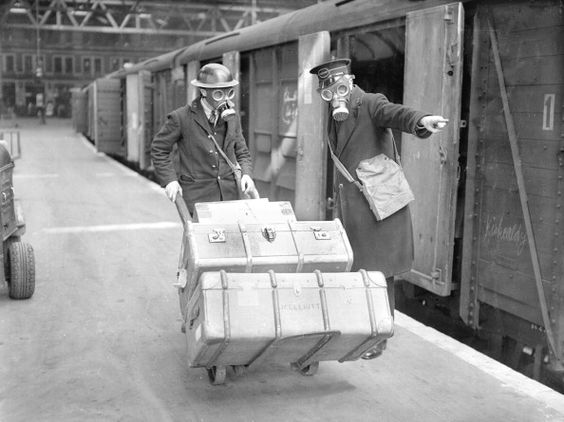 |
| British railway workers at the main London terminal of Southern Railway (photo by Planet News Archive/SSPL/Getty Images). |
The Luftwaffe bombs and sinks three ships, 1151-ton British freighter Angelesea Rose, 1548 ton British freighter Amiens and 1167 ton Norwegian freighter Bolette, north of St. Ives at the mouth of the Bristol Channel. There are eight deaths on the Amiens.
The Luftwaffe bombs and sinks 2826-ton Norwegian freighter Favorit south of the Faroe Islands. Everyone survives.
The Luftwaffe bombs and damages 159-ton British trawler King Athelstan near Ballinskelligs, Ireland. The skipper beaches the ship, but it later floats off after minor repairs and makes it to port.
The Luftwaffe damages British 5379-ton freighter Swedru in the Northwest Approaches. There are 24 deaths, including 7 passengers. The ship remains afloat as a derelict and eventually has to be sunk by gunfire.
German raider Kormoran is southwest of the Azores, on her way back to Germany, when the lookouts spot the 7739-ton Swedish iron ore carrier Sir Ernest Cassel. The Kormoran takes the crew aboard as guests/POWs depending on their nationality, then scuttles Sir Ernest Cassel. This is the final hostile encounter by the Kormoran on its first cruise, which began on 6 June 1940.
British 1578 ton collier Parnu collides with freighter Fluor about a dozen miles off Cape Wrath, Scotland. The Parnu eventually sinks.
The Kriegsmarine supply network remains active in the Atlantic, as tanker Nordmark refuels Italian submarines Archimede, Ferraris, and Gugliemotti.
Convoy OB 311 departs from Liverpool, Convoy HX 121 departs from Halifax.
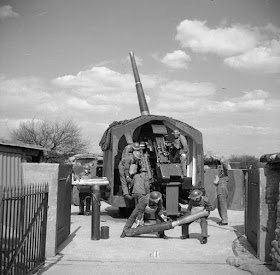 |
| The 52nd Heavy Regiment, Royal Artillery crew of a British 4.5-inch anti-aircraft gun unpack ammunition, 16 April 1941 (© IWM (H 8917)) |
Captain P.J. Mack is leading the 14th Destroyer Flotilla, composed of HMS Janus, Jervis, Mohawk, and Nubian and based in Malta, on a more-or-less routine patrol off Tunisia. His lookouts spot an Italian/German convoy commanded by Commander Pietro de Cristofaro. It is composed of five freighters and escorted by three Italian destroyers. Mack attacks the convoy (called the "Tarigo Convoy" after the lead escort destroyer) and sinks not only all five freighters/transports but also all three of the destroyers. Mack accomplishes this at the price of the Mohawk, which is scuttled off the Kerkenneh Islands. There are 168 survivors of the Mohawk and 43 deaths.
On the German side, there are 384 deaths of men who had been en route to the Afrika Korps, mainly from the 15th Panzer Division. The Italian navy puts to sea and eventually rescues 1248 out of about 3000 men who had been on the sunk ships.
The Axis ships lost are:
- 4205-ton Andana
- 2447-ton Aegina
- 2452-ton Arta
- 3704-ton Iserlohn
- 1590-ton Sabaudia
- Destroyer Tarigo
- Destroyer Lampo
- Destroyer Baleno
On land, Lieutenant General Erwin Rommel "personally, from the most forward lines" leads an attack on the Tobruk perimeter (quotes are from the Afrika Korps War Diary). This is at Ras Mdaauar. He uses his Italian forces, specifically the armored battalion of the Ariete Division and infantry from the Trento Division. The attack fails "because of the hesitant advance of the armored battalion" of the Ariete Division. The War Diary notes sourly that two Italian companies surrendered without putting up any fight.
General Wavell hurriedly stops further convoys of Operation Lustre bringing troops from Egypt to Greece. From now on, the convoys will move in the other direction, evacuating the expeditionary forces from Greece.
The British attempt a commando-style raid on Bardia, but the ships embarking the troops are recalled due to poor weather. The operation is rescheduled for when the skies clear. Another such raid is attempted on Marakeb, Libya, but destroyer HMS Decoy runs aground and the operation cannot be completed.
The first shipment of food to Great Britain under Lend-Lease arrives.
Anglo/Japanese Relations: The Japanese government issues a statement flatly denying that it has any designs on Singapore.
US/Canadian Relations: Canadian Prime Minister Mackenzie King visits with President Roosevelt. They will spend the next four days conferring in Washington, Virginia Beach and Roosevelt's home at Hyde Park. At some point during these meetings, they sign a defense production agreement.
US Military: MacDill Air Force Base, operational since 16 April 1940, receives its name today. It is named after World War I veteran Colonel Leslie MacDill.
British Homefront: Around this date, the British demolish with explosives the north water tower of the old Crystal Palace. This is simply done - there is no reason given or fuss made about it. The Crystal Palace grounds are being used to manufacture radar equipment, and the reason may be to make more room for this. Another conjecture is that the tower provides a navigational aid to Luftwaffe crews. In any event, it is the final and definitive end to the 1851 Hyde Park structure.
Minister of Labour Ernest Bevin introduces a National Registration of Women for war work. Previous attempts to enlist women had been voluntary; this is compulsory. The first registrations for the youngest (20-21) age group are set for 19 April 1941.
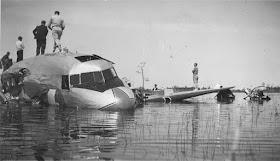 |
| Site of an Eastern Airlines DC-3 crash on 3 April 1941 in the Everglades west of Vero Beach, Florida. The crash is due to a storm. This photo was taken 16 April 1941 (Photo courtesy of the Indian River County Historical Society via TCPalm) |
April 1941
April 1, 1941: Rommel Takes Brega
April 2, 1941:Rommel Takes Agedabia
April 3, 1941: Convoy SC-26 Destruction
April 4, 1941: Rommel Takes Benghazi
April 5, 1941: Rommel Rolling
April 6, 1941: Operation Marita
April 7, 1941: Rommel Takes Derna
April 8, 1941: Yugoslavia Crumbling
April 9, 1941: Thessaloniki Falls
April 10, 1941: USS Niblack Attacks
April 11, 1941: Good Friday Raid
April 12, 1941: Belgrade and Bardia Fall
April 13, 1941: Soviet-Japanese Pact
April 14, 1941: King Peter Leaves
April 15, 1941: Flying Tigers
April 16, 1941: Battle of Platamon
April 17, 1941: Yugoslavia Gone
April 18, 1941: Me 262 First Flight
April 19, 1941: London Smashed
April 20, 1941: Hitler's Best Birthday
April 21, 1941: Greek Army Surrenders
April 22, 1941: Pancevo Massacre
April 23, 1941: CAM Ships
April 24, 1941: Battle of Thermopylae
April 25, 1941: Operation Demon
April 26, 1941: Operation Hannibal
April 27, 1941: Athens Falls
April 28, 1941: Hitler Firm about Barbarossa
April 29, 1941: Mainland Greece Falls
April 30, 1941: Rommel Attacks
2020

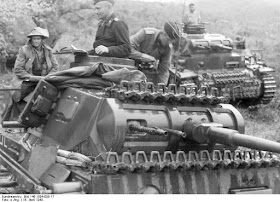
No comments:
Post a Comment